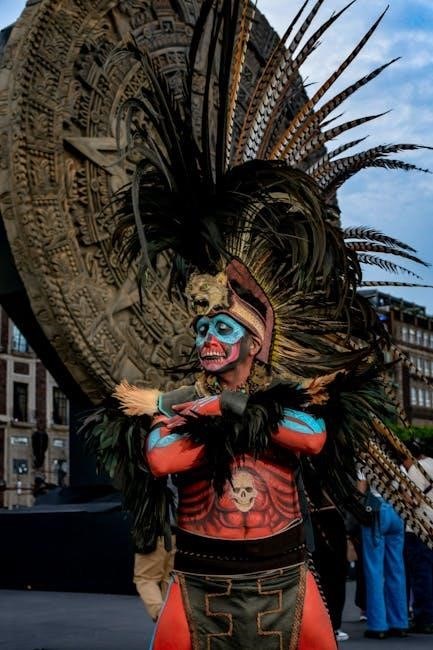Richard Wright’s Native Son is a groundbreaking novel that explores themes of race‚ identity‚ and socioeconomic inequality in 20th-century America through the story of Bigger Thomas․

Historical Context of the Novel
Richard Wright’s Native Son is set against the backdrop of racial tensions and socioeconomic disparities in early 20th-century America․ The novel reflects the harsh realities faced by African Americans during the Great Migration‚ when many moved from the rural South to urban centers like Chicago in search of better opportunities․ Wright draws from his own experiences growing up in a segregated society‚ where systemic racism and poverty perpetuated cycles of violence and despair․ The Great Depression further exacerbated these conditions‚ leaving many African Americans in precarious living situations․ The novel also critiques the superficial progress promised by the Harlem Renaissance‚ highlighting the ongoing struggles of Black Americans in a society that denied them equality and justice․ This historical context underscores the systemic oppression that shaped Bigger Thomas’s world and informed his tragic trajectory․
Plot Summary and Key Themes
Native Son by Richard Wright tells the story of Bigger Thomas‚ a young African American man living in poverty in 1930s Chicago․ The novel begins with Bigger accidentally killing Mary Dalton‚ the daughter of a wealthy white family‚ after being hired as her chauffeur․ This act sets off a chain of events‚ including the murder of his girlfriend‚ Bessie‚ and a subsequent manhunt․ The plot explores themes of race‚ identity‚ and class inequality‚ highlighting the systemic oppression faced by African Americans․ Through Bigger’s actions‚ Wright examines the psychological effects of racism and the limited opportunities available to Black individuals in a segregated society․ The novel is a powerful critique of racial injustice and a haunting portrayal of the consequences of societal marginalization․

Major Themes in Native Son
Race and Racism: Explores systemic oppression and racial tensions in America․
Identity: Portrays Bigger Thomas’s struggle with societal expectations․
Class Inequality: Highlights economic disparities and their impact on African Americans․
Race and Racism in 20th Century America
Richard Wright’s Native Son vividly portrays the pervasive racial prejudice and systemic oppression faced by African Americans in early 20th-century America․ Through Bigger Thomas’s experiences‚ the novel exposes the deep-seated racial tensions and discrimination that shaped the lives of Black communities․ Wright illustrates how societal structures‚ such as segregation and economic inequality‚ perpetuated racism and limited opportunities for African Americans․ The novel highlights the psychological and emotional toll of racism on individuals‚ as Bigger struggles with feelings of alienation and powerlessness․ By depicting these realities‚ Native Son serves as a powerful critique of the racial injustices embedded in American society during this period‚ sparking crucial conversations about race and equality․
Identity and Alienation in Bigger Thomas
Bigger Thomas‚ the protagonist of Native Son‚ embodies the struggles of identity and alienation faced by African Americans in a racially divided society․ His existence is marked by a profound sense of disconnection and marginalization‚ stemming from both external oppression and internalized racism․ Bigger’s actions‚ including his crimes‚ are driven by a desperate attempt to assert his identity and break free from the suffocating constraints imposed by a society that dehumanizes him․ Wright portrays Bigger’s internal conflict as a reflection of the broader psychological impact of systemic racism on Black individuals‚ who are often forced to navigate a world that denies them their humanity․ Through Bigger’s journey‚ the novel underscores the devastating consequences of alienation and the struggle for self-definition in a hostile environment․
Class Struggles and Socioeconomic Inequality
Richard Wright’s Native Son vividly portrays the class struggles and socioeconomic inequality faced by African Americans in 1930s Chicago․ Bigger Thomas‚ the protagonist‚ lives in abject poverty in the South Side‚ a stark contrast to the wealth of white neighborhoods․ The novel highlights how systemic poverty and lack of opportunities force individuals like Bigger into a cycle of desperation and crime․ Wright critiques the economic systems that marginalize Black Americans‚ denying them access to education‚ employment‚ and decent housing․ Bigger’s frustration with his circumstances is evident in his ill-fated robbery plan‚ which symbolizes the broader struggle against economic oppression․ Through Bigger’s story‚ Wright exposes the harsh realities of class inequality and its devastating impact on individuals and communities‚ emphasizing how societal structures perpetuate poverty and limit upward mobility for African Americans․ This theme remains a powerful commentary on systemic injustice․

Character Analysis
Richard Wright’s Native Son delves into the psychological and social dynamics of its characters‚ focusing on Bigger Thomas’s struggle with identity and the societal forces shaping his actions‚ alongside other pivotal figures․
Bigger Thomas: Psychological Profile
Bigger Thomas‚ the protagonist of Richard Wright’s Native Son‚ is a complex and deeply troubled character․ His psychological state is shaped by the oppressive societal conditions of racial segregation and poverty in 1930s Chicago․ Bigger’s actions are driven by a combination of fear‚ anger‚ and a desperate attempt to assert his identity in a world that denies him dignity and opportunity․ His internal struggle reflects the broader societal issues of racism and systemic inequality‚ which contribute to his alienation and eventual descent into violence․ Through Bigger’s psychological journey‚ Wright explores themes of identity‚ morality‚ and the dehumanizing effects of racism‚ creating a character that is both a product of his environment and a symbol of the tragic consequences of societal neglect․
Supporting Characters and Their Roles
In Native Son‚ Richard Wright crafts a cast of supporting characters who play pivotal roles in shaping Bigger Thomas’s journey and the novel’s themes․ Bigger’s mother‚ Mrs․ Thomas‚ embodies the moral and emotional anchor of the family‚ while his sister Vera represents innocence and vulnerability․ Mary Dalton‚ the privileged white woman whose death escalates the plot‚ symbolizes the racial and class divides that trap Bigger․ Her father‚ Mr․ Dalton‚ serves as a figure of oppressive power and economic control․ Jan Erlone‚ a communist sympathizer‚ offers Bigger a fleeting sense of camaraderie but ultimately fails to bridge the racial divide․ Each character reflects broader societal issues‚ with their interactions with Bigger highlighting the suffocating nature of systemic racism and economic disparity․ Together‚ they create a rich tapestry that underscores the novel’s exploration of identity‚ alienation‚ and injustice․

Literary Style and Structure
Richard Wright’s Native Son employs a raw‚ realistic prose style‚ blending vivid imagery with a tightly structured narrative that mirrors Bigger’s escalating emotional turmoil and societal entrapment․
Richard Wright’s Writing Style
Richard Wright’s writing in Native Son is characterized by a raw‚ unflinching realism that confronts the harsh realities of racial oppression and socioeconomic disparity․ His prose is direct and impactful‚ often employing vivid imagery to evoke strong emotional responses․ Wright’s use of blunt‚ forceful language reflects the intensity of Bigger Thomas’s experiences‚ creating a sense of immediacy and urgency․ The narrative structure‚ divided into three books‚ mirrors Bigger’s psychological journey‚ escalating from fear to defiance․ Wright’s ability to blend stark realism with poetic expression underscores the tragic dimensions of Bigger’s story․ His writing style not only critiques systemic racism but also humanizes Bigger‚ making his struggles relatable; Wright’s evocative descriptions of Chicago’s South Side and its oppressive environment further immerse readers in Bigger’s world‚ highlighting the societal forces that shape his destiny․
Narrative Structure and Its Impact
The narrative structure of Native Son is divided into three sections: “Fear‚” “Flight‚” and “Fate‚” each reflecting Bigger Thomas’s evolving psychological state․ This structure creates a sense of inevitable progression‚ mirroring Bigger’s descent into chaos․ The first section establishes Bigger’s oppressive environment and internalized fear‚ while the second captures his panic and disorganized attempts to escape consequences․ The final section shifts to a reflective tone‚ as Bigger confronts the meaning of his actions and the societal forces that shaped them․ This chronological and thematic division heightens the novel’s emotional impact‚ allowing readers to witness Bigger’s transformation from a reactive figure to one capable of introspection․ The structure underscores Wright’s critique of systemic racism by showing how societal constraints dictate individual outcomes‚ making the narrative both a personal tragedy and a broader social commentary․

Social and Political Commentary
Richard Wright’s Native Son delivers a powerful critique of systemic racism‚ class inequality‚ and societal oppression‚ using Bigger Thomas’s story to highlight the destructive impact of these forces on individuals and communities․
Critique of Systemic Racism
Richard Wright’s Native Son delivers a scathing critique of systemic racism in 20th-century America‚ exposing the deep-seated prejudices and structural inequalities faced by African Americans․ Through Bigger Thomas’s experiences‚ Wright illustrates how racism dehumanizes and marginalizes individuals‚ forcing them into cycles of violence and despair․ The novel portrays a society where racial segregation and economic oppression are ingrained‚ trapping characters like Bigger in a world of limited opportunities and constant fear․ Wright underscores how systemic racism perpetuates self-hatred and alienation within the Black community‚ as seen in Bigger’s internalized racism and his violent outbursts․ The novel also highlights the hypocrisy of white liberalism‚ as exemplified by the Dalton family‚ who exploit Black labor while claiming moral superiority․ By linking Bigger’s crimes to the societal conditions created by racism‚ Wright challenges readers to confront the moral failings of a system that perpetuates inequality and injustice․

Exploration of Violence and Crime
Richard Wright’s Native Son explores violence and crime as both a consequence of systemic oppression and a means of asserting power for the marginalized․ Bigger Thomas’s accidental murder of Mary Dalton and his subsequent killing of Bessie Mears are pivotal moments that expose the societal forces driving his actions․ Wright portrays violence not as inherent to Bigger’s nature but as a desperate response to the suffocating constraints of racism and poverty․ The novel critiques how systemic racism perpetuates cycles of violence‚ trapping individuals in a world where crime becomes a misguided form of rebellion․ Through Bigger’s actions‚ Wright sheds light on the psychological toll of oppression and the ways in which societal structures can lead to destructive outcomes․ The exploration of violence and crime serves as a stark indictment of the conditions that dehumanize and alienate marginalized communities․ This theme remains central to the novel’s social commentary․

Key Scenes and Their Significance
Native Son’s pivotal scenes‚ such as the murder of Mary Dalton and Bigger’s trial‚ underscore his psychological transformation and societal entrapment‚ revealing the devastating impact of systemic racism and oppression․
The Murder Scene and Its Consequences
The murder of Mary Dalton in Native Son is a pivotal and haunting moment that sets off a chain of irreversible events․ Bigger Thomas‚ driven by fear and panic‚ unintentionally kills Mary‚ a young white woman‚ after a night of drinking․ This act of violence escalates when he also kills his girlfriend‚ Bessie Mears‚ to silence her․ The murder scene is marked by chaos and desperation‚ highlighting Bigger’s emotional turmoil and the societal forces that have shaped his actions․
The consequences are far-reaching․ The police launch a relentless search for Bigger‚ and the community erupts in racial tension․ The trial that follows becomes a spectacle‚ with Bigger’s fate sealed by systemic racism․ The murder scene and its aftermath reveal the brutal realities of racial oppression and the dehumanization of Black individuals in America‚ making it a powerful critique of societal injustice․
The Trial and Its Social Implications
Bigger Thomas’s trial in Native Son serves as a stark representation of systemic racism and societal prejudice in 1930s America․ The trial is less about justice and more about reinforcing racial stereotypes and quelling white fears․ Bigger’s defense is weak‚ and the prosecution capitalizes on the public’s outrage to secure a conviction․ The trial highlights the deep-seated racial biases within the legal system and the broader society‚ as Bigger is condemned not for his actions alone but for the fear he embodies as a Black man․
The trial’s social implications extend beyond the courtroom․ It underscores the dehumanization of Black individuals and the systemic oppression they face․ Wright uses the trial to expose the hypocrisy of a society that condemns Bigger for his crimes while perpetuating the conditions that led to them․ The trial becomes a powerful indictment of racial injustice and a call for societal change․

Cultural Impact and Legacy
Richard Wright’s Native Son became an instant classic‚ sparking debates on race and identity․ Its raw portrayal of systemic racism influenced African-American literature and remains a powerful social critique․
Reception Upon Publication
Richard Wright’s Native Son was met with immediate acclaim and controversy upon its release in 1940․ Critics praised its unflinching portrayal of systemic racism and its impact on African-American lives‚ while others criticized its graphic violence and perceived nihilism․ The novel became a bestseller and was hailed as a groundbreaking work in the genre of urban realism․ It sparked intense debates about race‚ identity‚ and social inequality‚ cementing Wright’s status as a leading voice in African-American literature․ Despite its success‚ the book faced challenges‚ including bans in some regions due to its provocative content․ Its publication marked a pivotal moment in American literary history‚ challenging readers to confront uncomfortable truths about society․ The novel’s reception underscored its power to provoke thought and inspire change‚ solidifying its legacy as a classic of 20th-century literature․
Influence on Later African-American Literature

Richard Wright’s Native Son profoundly influenced African-American literature‚ becoming a cornerstone for future writers․ Its unflinching portrayal of systemic racism and its psychological effects inspired authors like James Baldwin and Ralph Ellison․ Baldwin’s Go Tell It on the Mountain and Ellison’s Invisible Man reflect similar themes of racial identity and societal alienation․ Wright’s work also paved the way for the Black Arts Movement of the 1960s and 1970s‚ encouraging writers to explore themes of race‚ class‚ and social justice․ The novel’s realist style and its focus on the African-American experience set a precedent for authentic storytelling․ Many authors have credited Wright with giving them the courage to address controversial topics․ Native Son remains a foundational text‚ shaping the trajectory of African-American literature and continuing to inspire new generations of writers and readers alike․
Richard Wright’s Native Son stands as a seminal work in African-American literature‚ offering a searing critique of systemic racism and socioeconomic inequality․ Through Bigger Thomas’s tragic journey‚ Wright exposes the dehumanizing effects of oppression‚ challenging readers to confront uncomfortable truths․ The novel’s unflinching realism and psychological depth have left a lasting impact‚ influencing generations of writers and thinkers․ Its exploration of identity‚ alienation‚ and violence remains relevant today‚ sparking ongoing discussions about race and justice․ Native Son not only reflects the harsh realities of its time but also serves as a powerful call for change‚ cementing its place as a cornerstone of American literary history․
